new posts in all blogs
Viewing: Blog Posts Tagged with: reluctant readers, Most Recent at Top [Help]
Results 26 - 50 of 128
How to use this Page
You are viewing the most recent posts tagged with the words: reluctant readers in the JacketFlap blog reader. What is a tag? Think of a tag as a keyword or category label. Tags can both help you find posts on JacketFlap.com as well as provide an easy way for you to "remember" and classify posts for later recall. Try adding a tag yourself by clicking "Add a tag" below a post's header. Scroll down through the list of Recent Posts in the left column and click on a post title that sounds interesting. You can view all posts from a specific blog by clicking the Blog name in the right column, or you can click a 'More Posts from this Blog' link in any individual post.
So,
 I’d like to take a side road of sorts in continuing our TeachingAuthors discussion on writers’ reader considerations.
I’d like to take a side road of sorts in continuing our TeachingAuthors discussion on writers’ reader considerations.
Yes, indeedy, I agree with my fellow bloggers: writing with passion trumps every consideration when we are writing to tell ourselves the story.
That kind of telling is the stuff of our firstdraft, our first pass, at who and what grabbed our hearts.Our second draft, though?
That’s the draft in which we make choices to grow a story and tell that story the best way possible to our intended reader.IMHO, the “best way possible” considers where that reader is chronologically, emotionally and cognitively so he or she can easily travel the story, can emotionally connect with the characters, can live inside the story and take its truths into his or her heart.When I read a student’s or writer’s manuscript for the very first time, when I read my own first drafts readying to finally revise, I read on behalf of the intended young reader.
Both the story and the format must be age-appropriate, of course.But do I know who claims the story and what it’s about? Am I grounded in the story’s time and place? What kind of story am I expecting? Left unanswered, those questions will likely force the intended reader to leave the story.Language must also be considered – word choice, sentence structure, metaphorical language, as JoAnn noted when she wrote about assessing reading levels in her Friday post.And richness of language need not be sacrificed – ever (!) - for clarity.JoAnn’s post brought a smile as I remembered my experience this past September attempting to write original poems for the newest addition to THE POETRY FRIDAY ANTHOLOGYseries (Pomelo Books), THE POETRY FRIDAY ANTHOLOGY FOR CELEBRATIONS, scheduled for an official April 1, 2015 pub date. The book features 150 poems in Spanish and English versions for preK and up, covering a wide variety of celebrations: Poem in Your Pocket Day to National Pet Week to Juneteenth to International Talk-Like-a-Pirate Day to World Bread Day to Winter Solstice. Invited writers could choose a day that spoke to them and try their hand at creating a poem.Hmmm…National Hat Month? I loved that idea and began fingering my way through my Roget’s Thesaurus, having a high ol’ time. Here’s the poem I first submitted, in celebration of National Hat Month:
Here’s the poem I first submitted, in celebration of National Hat Month: Mixed-up Mad Hatterisms to Celebrate Hat Month
Bees in your beanie.
A feather in your fez.
Pass the fedora.
Bearskin in hand.
Tom scored a tam trick!
Talking through your cap.
Tip o’ my turban.
Pass the sombrero.
Helmets off!
At the drop of a wimple.
Home is where you hang your beret.
(Copyright 2014 Esther Hershenhorn)
The anthology editor Janet Wong returned the poem, kindly reminding me of the designated preK-and-older audience.
 Hmmm…National Write a Letter of Appreciation Week?That’s the ticket! I thought.I brainstormed all sorts of letter-writing possibilities and settled on our TeachingAuthors Thank-u’s.
Hmmm…National Write a Letter of Appreciation Week?That’s the ticket! I thought.I brainstormed all sorts of letter-writing possibilities and settled on our TeachingAuthors Thank-u’s.Here’s the second poem I sent off to Janet:
A Haiku Thank You Dear (fill-in-the-blank),
You knew how to make me smile.
Thank-u very much.
(Copyright 2014 Esther Hershenhorn)
Janet remained kind while again reminding me of the designated preK-and-older audience.
“How about St. Patrick’s Day?” Janet wrote me. “There’s St. Patrick and everyone dressed in green and folks even dye their rivers green!”
I think I got this now! I thought. And I was off and running.
This time, though, after brainstorming All Things St. Patrick’s Day, I thought about my pre-K and K readers. I even Googled “St. Patrick’s Day curriculum for preschoolers” to learn the top 3 take-aways for little ones about this day. I’m currently unable to share my finally-accepted poem, “St. Patrick’s Day.”
I’m currently unable to share my finally-accepted poem, “St. Patrick’s Day.”Happy Writing!
Our young readers deserve our passion, our best writing – and – IMHO, our consideration of their chronological, emotional and cognitive needs.
Esther Hershenhorn


By:
Carmela Martino and 5 other authors,
on 10/29/2014
Blog:
Teaching Authors
(
Login to Add to MyJacketFlap)
JacketFlap tags:
exercise,
reluctant readers,
writing exercise,
Lenore Look,
Beginnings,
Carmela Martino,
Writing Workout,
Wednesday Writing Workout,
Children's Writer's and Illustrator's Market (CWIM),
Add a tag
Hi Everyone,
The clock is ticking! If you haven't entered for a chance to win a copy of the 2015 Children's Writer's and Illustrator's Market (CWIM) yet, see the link at the end of this post. The giveaway ends on Friday!
We're hosting the 2015 CWIM giveaway this month to celebrate the publication of my article in it: "Writing for Boys (and other 'Reluctant Readers')." The article contains advice and insights from four award-winning authors known for writing books that appeal to reluctant readers: Matt de la Peña, Lenore Look, David Lubar, and Steve Sheinkin. Today, I'm pleased to share a guest Wednesday Writing Workout from one of those authors: Lenore Look!
Here's Lenore's bio, as it appears in the 2015 CWIM:
Lenore Look recently released the sixth book in her award-winning (and boy-friendly) Alvin Ho chapter book series:
Alvin Ho: Allergic to the Great Wall, the Forbidden Palace, and Other Tourist Attractions (Schwartz & Wade). She is also the author of the
Ruby Lu series (Atheneum) and several acclaimed picture books, including
Henry’s First-Moon Birthday (Simon & Schuster),
Uncle Peter’s Amazing Chinese Wedding (Atheneum), and, her newest,
Brush of the Gods (Random House), a historical fiction account of the life of Wu Daozi, China’s most famous painter. Lenore taught creative writing at Drew University and St. Elizabeth College in New Jersey, and frequently speaks in schools in the United States and Asia. She has also co-presented the Highlights Foundation workshop "Writing for Boys" with Bruce Coville and Rich Wallace. She lives in Hoboken, New Jersey, and blogs frequently at
lenorelook.wordpress.com.
I'm a big fan of Lenore's Alvin Ho books, which is why I approached her about participating in the CWIM article. I haven't read
Alvin Ho: Allergic to the Great Wall, the Forbidden Palace, and Other Tourist Attractions yet, so I'll share the blurb for it that appears on
Indiebound:
Here’s the sixth book in the beloved and hilarious Alvin Ho chapter book series, which has been compared to Diary of a Wimpy Kid and is perfect for both beginning and reluctant readers.
Alvin, an Asian American second grader who’s afraid of everything, is taking his fears to a whole new level—or should we say, continent. On a trip to introduce brand-new baby Ho to relatives in China, Alvin’s anxiety is at fever pitch. First there’s the harrowing 16-hour plane ride; then there’s a whole slew of cultural differences to contend with: eating lunch food for breakfast, kung fu lessons, and acupuncture treatment (yikes!). Not to mention the crowds that make it easy for a small boy to get lost.
From Lenore Look and New York Times bestselling illustrator LeUyen Pham comes a drop-dead-funny and touching series with a truly unforgettable character.
Sounds like a fun read!
JFor today's WWW, Lenore shares a great exercise in beginnings.
Wednesday Writing Workout:Finding the Best Beginningby Lenore Look
When I worked as a newspaper reporter, the first thing I learned was how important the “
lede” or beginning of the story is. The first sentence is crucial. It’s called the “hook” because it snags your reader and reels them into your story. Without a strong hook, your reader will get away before you can tell them the five Ws and H – who, where, what, when, why and how.
When writing fiction, your hook is not just the best way to snag your reader, but it’s the place from which you will hang the rest of your story. It’s THAT important. For me, the beginning is the hardest part of the book to write. I’m faced with all my research, my characters, what I want to say, and a few ideas for scenes. It’s overwhelming. Where do I start? I pick something and have a go at it. It’s a mis-start, or a scrub, as they call it at NASA when a launch is aborted. I have many scrubs. When I find the spark that will finally launch my rocket, there’s more trouble. Often I will agonize over the first sentence for days, re-writing it, tweaking it, throwing it out, starting it over, again and again. But when I finally get it right, it’s blast-off! And the rest of the book seems to write itself.
Here’s my top-secret recipe for finding the strongest beginning, and I hope it helps you find yours.
How to Find the Strongest Beginning to Any Piece of Writing.1.
Sit down.
2.
Open your writer’s notebook.
3.
Ask the following questions:
a.
Who’s your character?
b.
What’s your setting?
c.
What does your character want?
d.
What are the obstacles in her way?
4.
Summarize the story you’re telling in one sentence.
5.
Write your summary sentence in the center of a blank page.
6.
Now surround your summary sentence with your answers to the questions from #3. Some people call this “clustering,” – if you draw circles around each of your sentences/ideas, it begins to look like a cluster of grapes. I don’t bother with the circles, instead I make lists, and surround my summary sentence with lists that answer the questions.
7.
Add your research as they fit under the different questions in #3.
8.
Step away.
9.
Eat some ice cream.
10.
Stare at the sunset.
11.
Call a friend.
12.
It’s important to start the next part with fresh eyes.
How to Find the Strongest Beginning, Part II1.
Look at your messy page(s).
2.
Find the smallest, most simple detail that captures your entire story.
3.
What you’re looking for is the KEY to your house. Keys are small. A small detail will open the door to the rest of the house, which is your story. All the rooms in your house are the different scenes that make up the story.
4.
Study carefully the beginnings to books you like.
5.
Using the detail you found in #2, and the inspiration you found from #4, write the most compelling beginning you can.
6.
Let it lead you into the first room of your story.
7.
Finish off the ice cream.
8.
Stare at the sunset.
9.
It may be the last sunset you see for a while.
10.
Writing a book takes a long time.
11.
Cry.
12.
Cry your eyes out. It’s only the beginning. You still have the middle and the end to tackle!
Writing Exercise Text © Lenore Look 2014, All rights reserved
Thanks, Lenore, for this terrific exercise! Readers, if any of you try today's WWW, do let us know how it works for you.
And don't forget to enter for a chance to win your own copy of the 2015 CWIM, where you'll be able to read additional helpful tips from Lenore. See
my last blog post for details. The giveaway ends October 31.
Happy Writing!
Carmela

By:
Gi Hallmark,
on 10/29/2014
Blog:
The Children's Book Review
(
Login to Add to MyJacketFlap)
JacketFlap tags:
Mystery,
Humor,
Reluctant Readers,
featured,
Books for Boys,
Suspense,
Books for Girls,
Random House Books for Young Readers,
Chris Grabenstein,
Brain Twisters,
Libraries,
Mysteries,
Ages 9-12,
Games,
Puzzles,
Librarians,
Add a tag
In Escape from Mr. Lemoncello’s Library, author Chris Grabenstein cleverly captures reader’s imaginations by combining the suspense of a thrilling game with the majestic nostalgia of great libraries, librarians, books and authors of past and present.
.
Howdy, Campers! Happy Poetry Friday! Poem and link to Poetry Friday are below ~
Our topic this round is Do you try to appeal to reluctant readers, or any particular type of reader, when you write?
Carmela's post addresses the topic of writing to reading levels thoroughly. She writes:"If you want your writing to appeal to boys and other reluctant readers, don't try to target this particular audience. That's right, DON'T target them. Instead, write what moves, excites, or interests YOU."
Mary Ann's post, agrees: "I write what I am passionate about. I write for my inner eleven-year-old. It's the best that I can do. It's all any of us can do."
As for me?
I titled this 3 Leading Ways to Target Your Writing for Children--NOT! because I agree with Carmela and Mary Ann's conclusions. Essentially, write with passion and you'll hit a bullseye.
 |
| from morguefile.com |
Here are three thoughts hopefully
slightly related to this topic:
1) I am a reluctant reader. Always have been. Once I dive into a book, I'm swimming, but getting to the edge of the pool, dipping my toe in? Terrifying. Every book. Every time.
2) Many years ago, former bookseller, and book reviewer
Janet Zarem was hired by my son's elementary school to talk to parents about reading. She began by passing out a paragraph in and asking us what it said. Okay, so let's try it. I'd like you to read this paragraph and tell me what it says. You have two minutes:
 |
| *see bottom of this post for attribution* |
When we saw the paragraph, we were scared'r than a long-tail cat in a room full of rockin' chairs.**
Isn't that a powerful way to show someone the world from a new or challenged or reluctant reader's point of view?
3) That's how scared many of us feel about learning
anything new.
For example,
UCLA Extension's Writers' Program is in the process of changing how its instructors post course materials for our students. We are moving from a platform called Blackboard to one called Canvas.
When I saw the first email about this, I rolled into a little ball. I felt as outdated and useless as a screen door on a submarine.***
I see now that I went through
the five stages of loss and grief, finally arriving at
acceptance: Wow--it's done, it didn't take long, and I am truly invincible.
 |
| Tah-dah--I did it! |
RELUCTANT
by April Halprin WaylandNew? New?Who are you talking to?
You’ll have to leave a message—
I think I have the flu.It’s too bad that you saw meI stick with tried and true.If you want revolution,I’ll leave it up to you.Who? Me?You found me up this tree?Just cut that sheet in two?And paste it here with glue?That’s all we have to do?
I’m standing on my head, now:I see your point of view.poem & drawing (c) April Halprin Wayland 2014=====================
Don't forget to enter our latest book giveaway for a chance to win a copy of the
2015 Children's Writer's and Illustrator's Market (in which our very own Carmela Martino has an article!). See
Carmela's post for all the details.
The giveaway ends Oct 31.
Poetry Friday is at
Merely Day By Day ~ Thanks, Cathy!
poem & drawing (c) April Halprin Wayland 2014
posted by April Halprin Wayland, who thanks you in Greek for reading all the way to here.
*from: http://en.wikipedia.org/wiki/Odyssey**
from: http://charlottenewcomers.blogspot.com/2008/01/southern-expressions-uglier-than.html***from:
http://www.examiner.com/article/southern-isms-50-of-the-funniest-southern-expressions-and-colloquialisms

By:
Carmela Martino and 5 other authors,
on 10/17/2014
Blog:
Teaching Authors
(
Login to Add to MyJacketFlap)
JacketFlap tags:
Teacher Resources,
children's poems,
David Harrison,
Carmela Martino,
Children's Writer's and Illustrator's Market (CWIM),
Poetry,
Poetry Friday,
Contests,
Book Giveaway,
reluctant readers,
books for boys,
Add a tag
Happy Poetry Friday, Everyone! Today I'll be sharing a fun, "spooky" poem by David L. Harrison. But first I'll tell you about my latest publication, an article in the 2015 Children’s Writer’s and Illustrator’s Market (Writer’s Digest Books), edited by Chuck Sambuchino. Then, at the end of this post, you'll find instructions for how to enter to win your very own copy of the 2015 Children’s Writer’s and Illustrator’s Market!
If you're not familiar with the
Children’s Writer’s and Illustrator’s Market (also known as the
CWIM),
here's an excerpt from the book's blurb.
"If you write or illustrate for young readers with the hope of getting published, the '2015 Children's Writer's & Illustrator's Market' is the trusted resource you need. Now in its 27th edition, 'CWIM' is the definitive publishing guide for anyone who seeks to write or illustrate for kids and young adults. Inside you'll find more than 500 listings for children's book markets (publishers, agents, magazines, and more)--including a point of contact, how to properly submit your work, and what categories each market accepts."
In addition to the market listing, the CWIM includes great articles, interviews, and success stories. This year's edition features my interview roundup article, "Writing for Boys (and other 'Reluctant Readers')." The piece contains advice and insights from four award-winning authors known for writing books that appeal to reluctant readers:
Matt de la Peña,
Lenore Look,
David Lubar, and
Steve Sheinkin.
Although these authors write a wide variety of books, and everything from picture books to young adult novels, there was one bit of advice they all agreed on: If you want your writing to appeal to boys and other reluctant readers, don't try to target this particular audience. That's right, DON'T target them. Instead, write what moves, excites, or interests YOU. Then, "revise it over and over until it hums," as Matt de la Peña said. All four of the authors shared additional, specific advice on how to reach reluctant readers, especially boys. So be sure to enter our giveaway below for a chance to win your own copy of the CWIM!
In researching "Writing for Boys (and other 'Reluctant Readers')," I discovered some very discouraging statistics about boys and reading. Not only do girls, on average, score higher on reading tests than boys, but the gender gap is widening. Fortunately, the news isn't all dire. As
Jon Scieszka, the first
National Ambassador of Young People's Literature and founder of Guys Read points out on the
GuysRead website:
". . . the good news is that research also shows that boys will read—if they are given reading that interests them."
Poetry can be a great way to hook boys (and other reluctant readers), especially if it's short, funny, and/or focuses on boy-friendly topics, such as sports, adventure, animals, and the supernatural. You'll find some wonderful books that fit this bill on the
GuysRead list of poetry books. I also recommend just about anything written by David L. Harrison. His book
Bugs: Poems about Creeping Things (Wordsong), illustrated by Rob Shepperson, is chock-full of poems with lots of boy-appeal. Here's one example:
cicada ghosts
Haunted skins cling emptily to the rough bark of the hackberry tree,
and farther up where I can't see, ghosts are buzzing eerily: zz-zz-zz-zz zeeeeee! © David L. Harrison, all rights reservedIf you'd like to see the wonderful illustration that accompanies this poem in
Bugs: Poems about Creeping Things, visit
this page on David's blog (after you enter our drawing below!).

Finally, before you head over to check out these resources or the other great poems in this week's
Poetry Friday round-up at
Today's Little Ditty, you'll want to enter to win your own copy of the
2015 Children’s Writer’s and Illustrator’s Market. You can do that via the Rafflecopter widget at the end of this post. You may enter via 1, 2, or all 3 options.
For option 2, "Leave a Blog Post Comment," you must share a comment to TODAY'S blog post and include your name!(If you prefer, you may submit your comment via email to:
teachingauthors [at] gmail [dot] com. )
The giveaway
ends on Oct. 31.
Good luck and happy writing!
Carmela
P.S. If you've never entered a Rafflecopter giveaway, here's info on
how to enter a Rafflecopter giveaway and the
difference between signing in with Facebook vs. with an email address. Email subscribers: if you received this post via email, you can click on the Rafflecopter link at the end of this message to access the entry form.
a Rafflecopter giveaway
By:
Bianca Schulze,
on 9/14/2014
Blog:
The Children's Book Review
(
Login to Add to MyJacketFlap)
JacketFlap tags:
Star Wars: Jedi Academy series,
Darth Vader Series,
Ages 4-8,
Picture Books,
Humor,
Illustrator Interviews,
Chronicle Books,
Reluctant Readers,
Scholastic,
featured,
Books for Boys,
Best Sellers,
Edward Gorey,
Bedtime Books,
Star Wars Books,
Jeffrey Brown,
E.H. Shepard,
Books into Movies,
Parenting Books,
Mark Alan Stamaty,
Brian Froud,
Illustration Inspiration,
Renee French,
Add a tag
Jeffrey’s Darth Vader series was originally geared towards adults as it was about the experience of being a parent; however, parents shared it with their kids and now both adults & kids love the series. Goodnight Darth Vader was created with both audiences in mind.
By:
Sue Morris,
on 9/8/2014
Blog:
Kid Lit Reviews
(
Login to Add to MyJacketFlap)
JacketFlap tags:
Series,
Reluctant Readers,
children's book reviews,
Books for Boys,
automobiles,
Peachtree Publishers,
William Bee,
5stars,
Library Donated Books,
Stanley the Builder,
Stanley the Farmer,
Stanley's Cafe,
Stanley's Garage,
Children's Books,
Picture Book,
picture books,
Favorites,
jobs,
Add a tag
 x
x
x
Stanley’s Garage
by William Bee
Peachtree Publishing 9/01/2014
978-1-5614-804-2
Age 3 to 8 32 pages
x
x
“Stanley is working at his garage today. From filling up Hattie’s red sports car with gas to changing the tire on Shamus and Little Woo’s blue car, it sure is a busy day. As his friends each come in with their car problems, Stanley knows just what to do to get them back on the road.”
Opening
“This is Stanley’s Garage. Who will drive in today?”
The Story
Stanley the hamster owns a garage and a green tow truck. He spends the day helping his friends. Hattie needs gas in her car, and, like the days of old, Stanley pumps the gas for her. I love her red sports car. Shamu’s car has a flat tire. While Shamu and Little Woo’s car has a flat tire, Charlie’s car is overheated, and Myrtle, in her purple car, needs towed back to Stanley’s garage. All day Stanley fixes auto problems. It’s a lot of work for one day. Stanley, smudged in black oil spots, walks home. He takes a bath, eats his supper, and heads to bed ready for tomorrow. What job will Stanley take on tomorrow? Will he be a chef at his own diner, or maybe the farmer that grows the food?
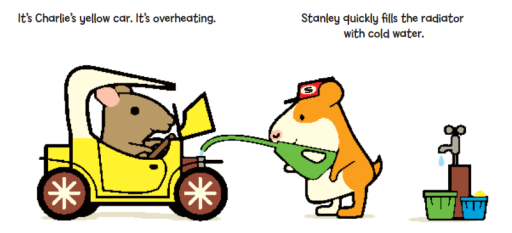
Review
Young boys will love the Stanley’s Garage. Stanley does a variety of jobs, all to help his friends. Young boys, and some girls, will enjoy Stanley in his new business. In his garage, Stanley works alone, unlike as a builder with Charlie. The illustrations are basic with large, easy to recognize shapes, separated by solid black lines, which help deepen the colors and drawing one’s attention. The colors are basic primary and secondary colors. Kids should be able to recognize each color, and he basic shapes that compose the items in Stanley’s world, if asked.
I love this clean presentation. The white background helps keep the eyes focused on the illustrations. I like watching Stanley helping his friends and I really wish, like Stanley, garages with gas pumps still pumped the gas for customers. What else has changed that kids might recognize? The text is simple with a few complex words related to automobiles. These words are: radiator, overheating, jacks, tow (no, not toe), and oily. Boys and girls will have a new vocabulary to use when playing with their toy cars.
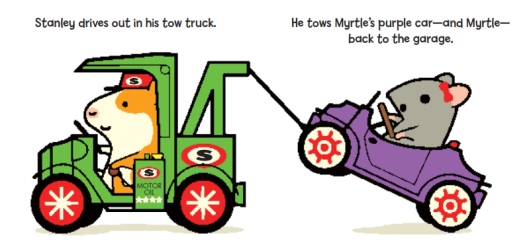
Young children will enjoy learning about the jobs Stanley takes on in this series. Along with building a house and running a garage, Stanley will be a chef in his own cafe, and grow food as a farmer. What other jobs Stanley might take on in the future is anyone’s guess. After reading Stanley’s Garage, young children will wonder why mom and dad pump their own gas. Stanley’s Garage can help prepare for kindergarten, as they learn the colors, shapes, and new words in each story.
The Stanley books are also a great choice for story-time. The illustrations, thanks to those black lines, are easy to see from a short distance. Stanley has more adventures on the way. Young children will eagerly await each new addition. Next, Stanley runs a cafe and then becomes a farmer.

STANLEY’S GARAGE. Text and illustrations copyright © 2014 by William Bee. Reproduced by permission of the publisher, Peachtree Publishing.
x
Purchase Stanley’s Garage at Amazon —B&N—Book Depository—Peachtree—your favorite bookstore.
—B&N—Book Depository—Peachtree—your favorite bookstore.
Stanley’s Collection




Review is HERE
Learn more about Stanley and his series HERE
Meet the author/illustrator, William Bee, at his website: http://www.williambee.com/
Check out William Bee’s fantastic blog: http://williambee.blogspot.com/
Find all of the Stanley series at the Peachtree Publishing website: http://peachtreepub.blogspot.com/
x
Also by William Bee
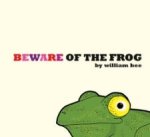
Beware of the Frog
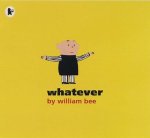
Whatever

And the Train Goes…
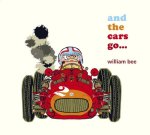
And the Cars Go…

Digger Dog – NEW
Migloo’s Day – March 24, 2015

x
Copyright © 2014 by Sue Morris/Kid Lit Reviews
x
Peachtree Publishing Book Blog Tour
Stanley’s Garage
Monday 9/8
Green Bean Teen Queen
Tuesday 9/9
Jean Little Library
Geo Librarian
Kid Lit Reviews
Wednesday 9/10
Chat with Vera
Thursday 9/11
Blue Owl
Filed under: 5stars, Books for Boys, Children's Books, Favorites, Library Donated Books, Picture Book, Reluctant Readers, Series Tagged: automobiles, children's book reviews, jobs, Peachtree Publishers, picture books, Stanley the Builder, Stanley the Farmer, Stanley's Cafe, Stanley's Garage, William Bee 







By:
Sue Morris,
on 9/7/2014
Blog:
Kid Lit Reviews
(
Login to Add to MyJacketFlap)
JacketFlap tags:
absent parents,
K.A. Holt,
Library Donated Books,
bullied,
6 Stars TOP BOOK,
Top 10 of 2014,
bullier,
seventh grade,
Poetry,
Middle Grade,
Favorites,
Chronicle Books,
poems,
Reluctant Readers,
children's book reviews,
Books for Boys,
middle grade novel,
Add a tag
 x
x
x
Rhyme Schemer
Written by K. A. Holt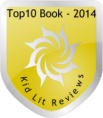
Chronicle Books 10/01/2014
978-1-4521-2700-2
Age 8 to 12 176 pages
x
x
“Kevin has a bad attitude. He’s the one who laughs when you trip and fall. In fact, he may have been the one who tripped you in the first place. He has a real knack for rubbing people the wrong way—and he’s even figured out a secret way to do it with poems. But what happens when the tables are turned and he is the one getting picked on?”
Opening
“First day of school.
My favorite.
Easy prey.
Giant John.
A parade float of himself.
The Story
Kevin, the class bully, is in seventh grade. He loves picking on certain kids. His teacher, Mrs. Smithson, does not like him, but does like to send Kevin to the principal’s office. She also turns a very blind eye when Kevin is no longer the bully, but the bullied. At home, Kevin is the accident baby with four “P” brothers: Patrick, Paul, Petey, and Philip. Mom and dad are both busy physicians with little time for home or Kevin.
Kevin keeps a notebook of his days at school, writing them in verse. Petey, in charge of driving Kevin to school, is a bully himself. When he notices Kevin’s notebook, Petey makes terrible fun of Kevin and then chucks the notebook out the car window. Kevin searches but cannot find it. Robin, who fits perfectly between the boy’s bathroom sink pipes, finds the notebook. It becomes blackmail. Robin wants to be the Poetry Bandit. Robin is a little jerk.
Mrs. Little, the librarian, knows it is Kevin tearing out pages from classics, circling and adding a letter or two, creating a unique poem, and then posting it at school for all to see. Mrs. Little soon takes to Kevin. She encourages Kevin to stop defacing school property and use paper other than pages from children’s classics for his unique poetry. As long as Robin has Kevin’s private notebook, sharing it at random, Kevin is nervous. There are a few bombs in the notebook that Kevin does not want exploding at school.
Review
Written in verse, Rhyme Schemer is a fast read. It is also an extremely enjoyable read that kept me laughing, sometimes loudly. Kevin is not a bad kid. His home life looks ideal to others, but reality is another matter. His parents are rarely home and brother Petey—who hates Kevin—is especially mean whenever possible. Bullies beget bullies. Kevin enjoys picking on his classmates. He meets with the principal much too often.
Kevin is not the classic bully who is mean and full of hate that spews out at other kids. Kevin is frustrated and trying to get his parent’s attention. His home life is mostly unfair and soon school will become unfair. The teacher ignores Robin’s attacks at Kevin, whether it is passing mean notes during class or ignoring a physical confrontation—where Kevin does not retaliate. She really does not like Kevin and then favors Robin, mainly because his father holds an important position.
I really like Kevin. He is a character you can easily favor, wanting him to catch a break. He’s a likable kid. Kevin pays a big price for defending Kelly, but he gains a friend, his first. I understand Kevin. He is the baby in a large family, but instead of being spoiled, he is picked on, sometimes harshly for no real reason. In a house full of people, Kevin is alone. What must it be like to have four brothers, all wanted, and with planned-out names beginning with a “P” (I wish I knew why), but he is the accident with a name beginning with the wrong letter. This alone must make him feel alienated from his family. Kevin deals with school unfairness and home by becoming a feeling-less, like stone.
Kids will like Rhyme Schemer. They will like Kevin. Kids will see a bully from a new perspective. The text is funny in so many places, and even sad in a few. Ms. Holt’s writing style is enjoyable and kid like. Kevin is the narrator, but I wonder if he is also the author and Ms. Holt his conduit. Kevin wrote several Odes to his principal’s tie. Some are in the story and some are at the end of the book. Don’t pass these by.
“[Clearing throat noise here.]
x
O, Principal’s tie
You make me want to puke
Because you are the color of
Squishy, moldy fruit”
Reluctant readers will also find Rhyme Schemer easy to read. At the end, I was not ready to stop reading. I wanted more. There are no unanswered questions, no threads laying in wait for a resolution; I simply want to read more of Kevin’s poetry. Rhyme Schemer is one of those rare books that stay with you, long after the last page flips over. I hope to read Kevin’s eighth grade notebook.
RHYME SCHEMER. Text copyright © 214 by K. A. Holt. Reproduced by permission of the publisher, Chronicle Books, San Francisco, CA.
Read a excerpt of Rhyme Schemer HERE (no cost)
Buy Rhyme Schemer at Amazon —B&N—Book Depository—Chronicle Books—your favorite bookstore.
—B&N—Book Depository—Chronicle Books—your favorite bookstore.
Learn more about Rhyme Schemer HERE
Meet the author, K. A. Holt, at her website: http://kaholt.com/books/
Find more middle grade books at the Chronicle Books website: http://www.chroniclebooks.com/
Also by K. A. Holt

Brains for Lunch

Mike Steller Nerves of Steel
Coming Fall 2015 – House Arrest – Chronicle Books

Copyright © 2014 by Sue Morris/Kid Lit Reviews
I really like the author information on the back inside book jacket.
x
“K. A. Holt is a writer
a mama
a bad (but fearless) cook.
She has written three
(three!)
books for kids.
Also?
She shelved books
in the library
during grade school.
Ms. Holt claims
(claims!)
she never had a detention.
Believe what you want.”
Filed under:
6 Stars TOP BOOK,
Books for Boys,
Favorites,
Library Donated Books,
Middle Grade,
Poetry,
Reluctant Readers,
Top 10 of 2014 Tagged:
absent parents,
bullied,
bullier,
children's book reviews,
Chronicle Books,
K.A. Holt,
middle grade novel,
poems,
poetry,
seventh grade 







By:
TCBR Contributor,
on 8/31/2014
Blog:
The Children's Book Review
(
Login to Add to MyJacketFlap)
JacketFlap tags:
Ages 0-3,
Humor,
Reluctant Readers,
Board Books,
Fathers,
Nina Laden,
Animal Books,
Matching,
Daddy Books,
Boards Books,
Add a tag
Daddy Wrong Legs, by Nina Laden, is a colorful board book split down the middle and offers a top and bottom page turn.
By:
Sue Morris,
on 8/21/2014
Blog:
Kid Lit Reviews
(
Login to Add to MyJacketFlap)
JacketFlap tags:
middle grade books,
Karla Oceanak,
Aldo Zelnick,
5stars,
Library Donated Books,
Bailiwick Press,
Kendra Soanjer,
comics,
Middle Grade,
Favorites,
Series,
Reluctant Readers,
children's book reviews,
Books for Boys,
Add a tag
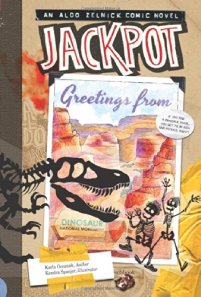 x
x
Jackpot: An Aldo Zelnick Comic Novel (#10) 
Written by Karla Oceanak
Illustrated by Kendra Spanjer
Bailiwick Press 6/10/2014
978-1-934649-49-7
Age 7+ 160 pages
x
x
“Finding a dinosaur bone is like hitting the jackpot, right? Dino fossils are worth millions! Plus you get to b famous! You’re minding your own kid business when bam!—out of the mud pop fortune and glory. Ka-ching! That’s how I thought it would go, anyway, after my best friend, Jack, and I found a fossil in our neighborhood ditch. But as usual, grown-up rules made things way too complicated.”
Opening
“I wish we could play outside. This morning, I said that. I mean, I actually heard my own voice speak those exact words. Me. Aldo Zelnick.”
The Story
Aldo and his best friend, Jack, actually did go outside to play. It was cold and muddy causing the boys to slip and slid right into a neighborhood ditch. This is when Jack finds a big rock that, when cleaned, is much better than a rock. It is a fossil—a dinosaur fossil, right from their own backyard.
Aldo believes the fossil is worth millions of dollars and holds this hope out to the very end. Jack is thinking only of fame. A famous paleontologist, a famous middle grade paleontologist, would be cool, he thought. Jack holds out this hope to the very end. This is the only contention between Aldo and Jack: fame or fortune, but why not both!
The boys head to the natural history museum to find out what kind of fossil they found and, for Aldo, how much it is worth. Aldo thinks the museum will pay him on the spot—they do not. But, it is a dinosaur bone and the ditch might just have more bones. Now the boys must get the neighborhood to consent to digging up the ditch, and then find the rest of the dinosaur. Once done, Aldo and Jack will go on tour with their fame and fortunes. If only they can keep everyone out of the ditch until excavation day.
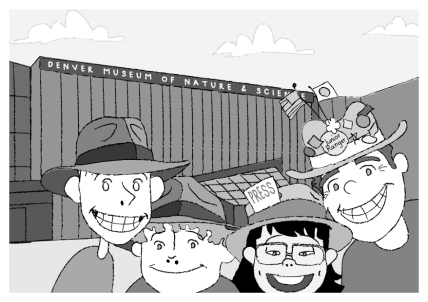
Review
When we last read about Aldo he was skiing in Ignoramus. Since then, Aldo and Jack have changed only incrementally, as they normally would. I like that the authors are not maturing the characters quickly. Of course, with twenty-six books, they have lots of room to let the characters blossom slowly. Still, Aldo may be in college by the time “Z” hits the shelves. Aldo is still using his diary to write about his life and then—oh, I meant his journal, so sorry. Sometimes a good character just sticks with you and Aldo is one of those characters. He also wants you to know he is an artist and draws some terrific scenes that help readers visualize his stories.
In “J,” for Jackpot, Aldo and his best friend Jack finally go outside to play. They do not pick the best day, as it is cold and the ground is muddy and slippery. Aldo and Jack slip and slide into a neighborhood ditch. In the ditch Jack loosens a great looking rock. The rock turns out to be a dinosaur bone and more could be in that ditch. Aldo thinks this is great fortune, as in money. Jack thinks this is fortunate, as in fame. He would love a dinosaur named after him. Aldo would probably like a bank, or at least the largest vault, named after him. They have hit the JACKPOT!
As in books A, B, C, D, E, F, G, H, and I, J (for Jackpot) is crazy and funny with loads of mishaps, misunderstandings, and a girl interfering—or trying to—with Aldo and his journals. Jackpot is not a graphic novel. It contains enough text to keep the story on track and moving, but not so much as to crowd out the wonderful illustrations meant to be from Aldo. I love the detailed illustrations that greatly enhance the story. Aldo and Jack both sport Indiana Jones hats (fedoras). Kids will love the black and white “doodles” Aldo draws on nearly every page.
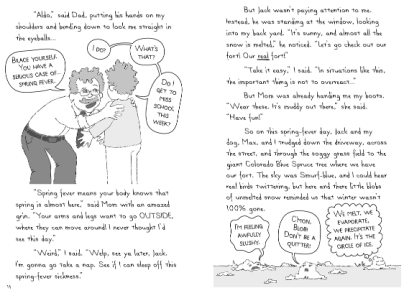
I enjoyed Jackpot, reading it in one sitting. Middle grade kids—especially reluctant readers—will love this series. The characters are believable, multi-dimensional, likable and in many ways familiar to everyday life. Reluctant readers will appreciate the story staying on track and the short chapters. Kids can stop reading at any point, and when ready, easily reemerge back into the story. This is most terrific for reluctant readers who are at a distinct disadvantage with continuing a book midway through.
As far as the actual writing is concerned, the story stays on point even when Aldo goes off on a tangent. Aldo’s tangential thoughts are about money. In several illustrations, Aldo has made long lists of numbers needing added to project his coming wealth. The characters, especially Aldo and Jack, are easy to care about as the story progresses. If you have been reading the alphabet series known as Aldo Zelnick, you already care about Aldo and Jack, but the author makes no assumptions and brings new readers into the fan club.
Jackpot is the tenth book in Aldo’s series. I like that each of these books introduces new words that begin with that book’s letter. Jackpot, then, has words beginning with the letter “J.” Examples include jabbering, jack squat, jicama, and several French words like Joie de vivre and jugo de naranja. There is a glossary in the back, which defines each “J” word. In the text, the highlighted words are marked with an asterisk (*).
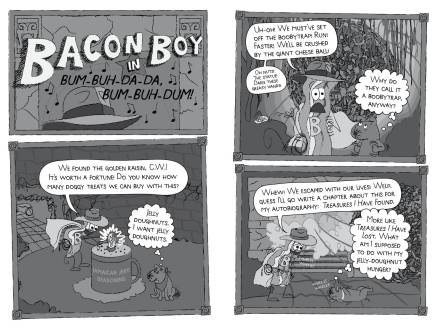
The Aldo Zelnick series is similar to The Wimpy Kid except that Jackpot, and every book thus far, have better defined illustrations. I like the “J” words in Jackpot. The glossary defines each of these words. I also like reading the comic Bacon Boy by Aldo Zelnick. How often do you get two books in one and both books are terrific? Aldo and Bacon Boy have a lot in common. I think Bacon Boy is Aldo and a safe, funny way for Aldo to document his childhood. Kids will laugh their hinnies off, no external exercise needed.
JACKPOT: AN ALDO ZELNICK COMIC NOVEL (#10). Text copyright © 2014 by by Karla Oceanak. Illustrations copyright © 2014 by Kendra Spanjer. Reproduced by permission of the publisher, Bailiwick Press, Fort Collins, CO.
x
Purchase Jackpot at Amazon —B&N—Book Depository—Bailiwick Press—Your Favorite Bookstore.
—B&N—Book Depository—Bailiwick Press—Your Favorite Bookstore.
x
Learn more about Jackpot HERE.
Meet the author, Karla Oceanak, at her website: http://www.karlaoceanak.com/
Meet the illustrator, Kendra Spanjer, at her website: http://www.kendraspanjer.com/
Find more Aldo Zelnick books at the Bailiwick Press website: http://www.bailiwickpress.com/
.
Also by Karla Oceanak & Kendra Spanjer

Ignoramus #9

Hotdogger (#8)
Read Hotdogger Review HERE.
Read Ignoramus Review HERE.
x
x

x
x
Copyright © 2014 by Sue Morris/Kid Lit Reviews
Filed under:
5stars,
Books for Boys,
Favorites,
Library Donated Books,
Middle Grade,
Reluctant Readers,
Series Tagged:
Aldo Zelnick,
Bailiwick Press,
children's book reviews,
comics,
Karla Oceanak,
Kendra Soanjer,
middle grade books 







By:
Sue Morris,
on 8/14/2014
Blog:
Kid Lit Reviews
(
Login to Add to MyJacketFlap)
JacketFlap tags:
humor,
Series,
Reluctant Readers,
children's book reviews,
pranks,
family relationships,
4stars,
jinxed,
Library Donated Books,
Jespar Jinx,
Marko Kitti,
reluctant reaers,
Spanish teacher,
Children's Books,
Chapter Book,
Add a tag
 x
x
x
Jesper Jinx, Book 1
by Marko Kitti
published by Marko Kitti 4/28/2014
978-1-4974-5822-2
Age 7 to 9 152 pages
x
“Jesper Jinx is eleven, and probably the unluckiest person in all of Puffington Hill. Everything he touches seems to end up in sweet disaster. Hence his nickname “Jinx.” In this first book of Jesper Jinx’s wonderfully wicked adventures you’re going to meet Jesper’s family and Snowy the Cat. Also, there’s a mysterious new classmate with a moustache. And it‘s up to Jesper to launch his famous Boredom Breaker. What harm would it do to have a little fun?”
Opening
“Jesper Jinx watched as his older sister Melinda popped her soda an open and took a small sip from it.”
The Story
Jesper Jinx loves his pranks but the pranks have earned him a nickname. Even some of his best pranks are jinxed, like the time he switched his sister’s beloved energy drink, Guaraná Antarctica, with a horrible homemade concoction. She deserved it. She snooped at his diary. At dinner, dad took a swing of Melinda’s “energy drink” and about gagged, no, wait, he did gag and so did Melinda. She was well worth it, but not dad. Jesper ran out of the house before anyone could accuse him and ran into the author of this book. Sworn to secrecy, the author agreed to write a book only Jesper’s eyes would see. This is that book.

Two short stories are included in book 1: Jesper Jinx and the Colourful Cat and Jesper Jinx and the Spanish Shenanigans. For animal lovers, the first story will amuse you, especially if you are owned by a dog. Jesper accidentally causes Snowy, the cat, to turn several shades of red moments before his mother is to show her off to a disliked neighbor. To make matters worse, the cat, named for its pure white coat of fur, disappears, like magic. One minute, she was under a towel and the next, gone. Of course, this is when the dreaded neighbor rings the doorbell. Is it really magic? Is Snowy a magical cat? Mom believes so, if only for a short minute. Then she realizes Jesper is involved and has him bathe Snowy. Everyone knows cats do not like bathes. Jinxed!  With claws!
With claws!
In the Spanish Shenanigans, it is not Jesper pulling the shenanigans. There is a new kid in class, and he has a moustache on his upper lip. His name is José Maria, and he has a moustache, a real one, and a deep voice. José claims everything grows faster in the hot Spanish sun, but Jasper is not inclined to believe him, well, he is inclined enough to show José all of his best pranks. School will not be the same for Jesper and his best friend Oliver. Their teacher, Miss Parrot, who likes to repeat what she hears, has a life-changing experience and leaves school—for good. Jesper and Oliver will get a new teacher. A short-for-his-age teacher who has a deep voice (girls will swoon over), and a real moustache on his upper lip. The new teacher now knows all of Jesper and Oliver’s favorite pranks. Jinxed!
Review
I read Jesper Jinx in one sitting and enjoyed the crazy antics of both Jesper and the author. The author begins by explaining how he came to Puffington Hill, home of Jesper, and how he acquired Jesper’s stories— and the secrecy by which he swore to handle his stories. There is even a certificate of secrecy readers must sign. Running out of the house after dad takes a swing of Melinda’s tampered Guaraná Antarctica energy drink, Jesper runs into the vacationing author. Then  the stories begin. Oh, yes, Jesper Jinx is Finnish author, Marco Kitti’s first English language chapter book.
the stories begin. Oh, yes, Jesper Jinx is Finnish author, Marco Kitti’s first English language chapter book.
I like the story of the red Snowy cat and its disappearance from under the towel. The cat’s portrayal is realistic. I cannot count the number of times my cat is not where he was only moments before and then suddenly shows up where he could not possibly be at. The behavior is enough to drive a person to dogs. The humor is well timed and Jesper’s reactions are convincing. I love that mom is going to show off a cat she otherwise wants nothing to do with. Snowy belongs to Jesper when the litter box needs cleaned or the cat is in mom’s space. But bring the snooty neighbor comes around Snowy becomes mom’s treasure. I like how the author includes bits of life that are true for many readers. Like dad, engrossed in his newspaper, only coming up for air when he wants something, but don’t try to talk to him.
In the shenanigans story, it is confusing why this new kid is suddenly in class and why the teacher swooned whenever she said his name. The teacher is wacky, repeating what the student said, before answering.
“Yes, Jesper?” said Miss Parrot. “Do you have something to share with us all?”
“No,” said Jesper.
“No,” said Miss Parrot. “Is there something . . . ?”
“No, Miss Parrot,” said Jesper.
“No, Miss Parrot,” repeated Miss Parrot. “Then how about you, Oliver?”
“I can’t think of any questions, Miss Parrot,” said Oliver.
“Think of any questions, Miss Parrot!” said the teacher.
Yes, it can get tiring, but then Miss Parrot quickly disappears. She is busy driving her souped-up Mercedes. The story is about José Maria, Jesper, and Oliver’s budding friendship. It is odd that José has a moustache but then, I can remember certain boys tended to get their hairy lip early. So, I believed this. The deep voice at eleven I also believed. Maybe he is older and flunked a few grades. You must believe or the story cannot go on. Poor Jesper, he is jinxed the moment the man-boy walks into his classroom. Trying to be a nice kid, Jesper and his friend Oliver befriend José. José asks Jesper about pranks, so Jesper shows him the best pranks he an Oliver pull on teachers.

Jesper is a likable character, kids age 7 and up will enjoy, along with all of his the crazy stories. The stories are short, and the vocabulary basic, so a reluctant reader can enjoy Jesper’s antics. Jesper Jinx will entertain both boys and girls who like crazy plot twists you don’t expect. The antics are similar to those in the the Aldo Zelnick alphabet book series.(Reviewed here: “J” “K”) Just remember one important detail, you must keep the contents of these books a secret. Jesper believes the author is only printing one copy for himself only. If he finds out that is not true, he will stop telling the author his stories. Jesper Jinx is a welcome addition to chapter books and books for reluctant readers.
JESPER JINX. Text and illustrations copyright © 2014 by Marko Kitti. Reproduced by permission of the publisher, Marko Kitti,
Purchase Jasper Jinx at Amazon —B&N—Book Depository—CreateSpace—Marko Kitti—your favorite bookstore.
—B&N—Book Depository—CreateSpace—Marko Kitti—your favorite bookstore.
Check out what a local Gargoyle had to say about Jesper Jinx right HERE.
Learn more about Jasper Jinx HERE.
Meet the author / illustrator, Marko Kitti, at his website: http://www.markokitti.net/en.html
x
x

x
x
copyright © 2014 by Sue Morris/Kid Lit Reviews
Filed under:
4stars,
Chapter Book,
Children's Books,
Library Donated Books,
Reluctant Readers,
Series Tagged:
Chapter book,
children's book reviews,
family relationships,
humor,
Jespar Jinx,
jinxed,
Marko Kitti,
pranks,
reluctant reaers,
Spanish teacher 







By:
Sue Morris,
on 8/11/2014
Blog:
Kid Lit Reviews
(
Login to Add to MyJacketFlap)
JacketFlap tags:
Children's Books,
Middle Grade,
Series,
Reluctant Readers,
Books for Boys,
Peachtree Publishers,
middle grade book,
Fred Bowen,
4stars,
Library Donated Books,
chidren's book reviews,
Dartmouth College Big Green,
girls high school soccer,
girls playing high school football,
high shool football,
transforming yourself in sports,
Add a tag
PEACHTREE BOOK BLOG TOUR
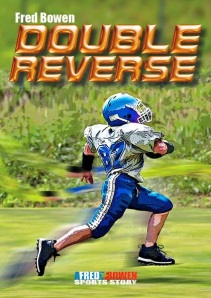 x
x
Double Reverse 
by Fred Bowen
Peachtree Publishers 8/01/2014
978-1-56145-814-1
Age 7 to 12 144 pages
x
x
“READY . . . SET . . . HUT ONE!
“Jesse Wagner has run pass patterns with his older brother Jay since he was a little kid. Now Jay’s heading to college and Jesse’s a wide receiver for the high school freshman team, the Panthers. The season starts off badly, and things get even worse when the Panthers quarterback is injured. Jay suggests that Jesse try out as QB. Jesse knows the playbook backwards and forwards, but he feels that he’s too small for the role. He just doesn’t look the part. Can he play against type and help the Panthers become a winning team?”
Opening
“Ready . . . set . . . hut one!” Jesse Wagner and his older brother Jay were running pass patterns at Hobbs Park, just as they had a thousand times before.”
The Story
Jesse Wagner is finally in high school and the wide receiver for the freshman football team. Quinn (right tackle), and Langston (reserve wide receiver), two of Jesse’s best friends, also play on the Panther freshman football team. Jesse has been running pass patterns with his older brother, Jay and now knows all of the plays the Panthers use without referencing the playbook. Jay, last year’s All-Conference quarterback, is now off to Dartmouth College to play quarterback there.
Henry, the freshman quarterback for the freshman Panthers, poor kid, is confused about every play, cannot seem to remember any of them, and his throws are too short or too long, too high or too wide. Henry looks like an all-star quarterback and will scare the other team . . . until the first play. Jesse nearly suffers a concussion trying to go after a bad pass from Henry. The one who does get hurt is Henry. A Panther lineman stumbles into Henry causing a season ending injury.
Meanwhile, Jay is a good quarterback, but so are many other boys. He does not get the job. His coach wants him to play safety. Home for the weekend to decide if he will quit the team or play safety, Jay talks to Jesse while throwing around a football. Jay agrees to accept safety if Jesse agrees to try out for quarterback, now t hat Henry is gone the position is open. Deal made, Jay returns to Dartmouth and Jesse asks to try out. The assistant coach thinks the shorter than the average quarterback could work. The coach is not buying it. A few practice plays and Jesse has won the position and the nickname “Tark” after Fran Tarkington, a short quarterback that ruled the game in the NFL. Only problem is, with quarterback shored up, another game-busting problem becomes visible: the kicking game sucks. The Panthers sorely need a kicker that can kick beyond midfield.
Savannah, who happens to play the other football game (soccer), as the goalie, can kick the ball with a huge depth and a long hang-time impressing Jesse and his friends, and giving them an outrageous idea. Jesse suggests they ask Savannah to kick for their football team. Savannah is intrigued, but will the coaches? Will the freshman football coaches sign off on a girl football player? Will the girls soccer coach sign off on his best player leaving the team to play football? Can Savannah even make a difference to the plagued freshman Panther football team?
Review
Double Reverse highlights high school football, three stars of the game, and situations that place all three in odd positions. For Jay, a big man on a high school campus, he easily becomes a little man on a college campus, and Jay is having trouble accepting this. He thinks ending his football career is a better idea than taking his talent in another direction. He seriously considers quitting the team—and his Dartmouth education—rather than change his positions and play safety.
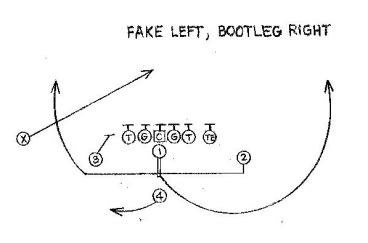
From Panther’s Playbook
Jesse is a great wide receiver, or he would be great if the quarterback could ever get the ball to him. Then injury takes Henry—the quarterback—out during the first game. The Panthers do not have a viable quarterback and Jay thinks Jesse can do it. Jesse believes he is too short to play quarterback—he just does not look the part as Henry did, but Henry couldn’t throw the ball or remember plays so what kind of help was his quarterback looks? The brothers make a pact to try the other positions. Turns out, both are great in their new spots and both are happy.
I enjoyed reading Double Reverse. It has a lot of football action and even gives away some of the panther’s playbook. Double Reverse is also about reinventing yourself when the need or opportunity arises. It is about diversifying yourself, rather than being one set thing all your life. I get how Jay feels, but I do not understand how he could risk his education. Jesse and Savannah both soon learn perception and reality do not always match when they are good at positions neither saw themselves at—Jesse as quarterback and Savannah as goalie (soccer) and then kicker (football).
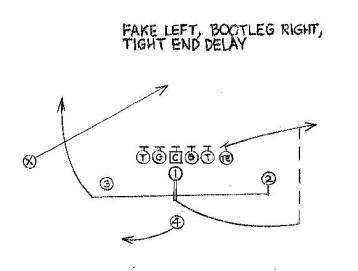
Jesse’s Inspired Change of Play
Girls will love the character of Savannah who does not want to be the goalie, yet turns out to be a killer goalie. When the boys need her, she reinvents herself as a football player and helps her friends finally win a game. Savanna reflects the change in football with more and more girls playing at the high school level and commend the author for inventing this character and making her so fresh and vibrant. There is a lot of ego in girl’s sports, and girls will enjoy that Savannah’s kicking game is the reason the football team wins a game.
Mainly, Double Reverse shows the importance of growth as children age and experience new things. Sometimes it is good to be the best. Other times it is good to be a team player and sacrifice your glory for the team’s glory. I am not interested in football, yet enjoyed Double Reverse very much, and understand the game better after reading this book. I actually loved all the action during the games. After the story are the true stories of two legends, Fran Tarkington and Cal Ripken, both thought to be wrong to play their respective positions in the pros and the inspiration for Double Reverse.
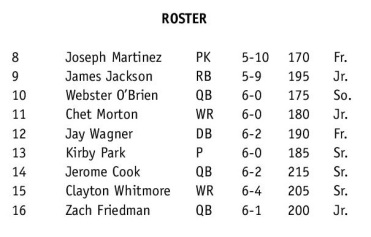
Dartmouth College “Big Green” Roster
No one is expecting a winning season, but the Panthers find ways to overcome the odds against them, some by breaking stereotypes and putting the team before themselves—Henry does this upon his return. Boys and girls that like football, be it the American European, will love reading Double Reverse. The story is much more than a football story, making it appealing to both boys and girls, and it’s a story the reluctant reader can savor thanks to shorter sentences and an uncomplicated vocabulary. Double Reverse is an all-around winning story.
DOUBLE REVERSE. Text copyright © 2014 by Fred Bowen. Illustrations copyright © 2014 by XXXXXXXXX. Reproduced by permission of the publisher, Peachtree Publishers, Atlantic, GA.
Purchase a copy of Double Reverse at Amazon —B&N—Book Depository—Peachtree Publishers—at your favorite bookstore.
—B&N—Book Depository—Peachtree Publishers—at your favorite bookstore.
Learn more about Double Reverse HERE.
Meet the author, Fred Bowen, at his website: http://www.fredbowen.com/
Find other great books at the Peachtree Publishers website: http://peachtree-online.com/
Also Writte by Fred Bowen

The Kid Coach

Winners Take All

Soccer Team Upset

Off the Rim

Perfect Game
x
x
x
Reviewed HERE.
x
x
x
x
x

x
x
x
copyright © 2014 by Sue Morris/Kid Lit Reviews
x
x
x
x
PEACHTREE BOOK BLOG TOUR
Double Reverse
Monday 8/11
The Write Path http://www.dorinewhite.blogspot.com/
Tuesday 8/12
Kid Lit Reviews http://kid-lit-reviews.com/
Geo Librarian http://geolibrarian.blogspot.com/
Wednesday 8/13
Librarian in Cute Shoes http://www.librarianincuteshoes.blogspot.com/
x
x
Filed under:
4stars,
Books for Boys,
Children's Books,
Library Donated Books,
Middle Grade,
Reluctant Readers,
Series Tagged:
chidren's book reviews,
Dartmouth College Big Green,
Fred Bowen,
girls high school soccer,
girls playing high school football,
high shool football,
middle grade book,
Peachtree Publishers,
transforming yourself in sports 








 Back in 2005, I started writing a book based on something that really happened: a blind girl who was briefly and accidentally kidnapped when her parents left the keys in the car and someone stole it. Only in my book, the thief kept the girl and she had to figure out how to escape.
Back in 2005, I started writing a book based on something that really happened: a blind girl who was briefly and accidentally kidnapped when her parents left the keys in the car and someone stole it. Only in my book, the thief kept the girl and she had to figure out how to escape.
My editor at the time felt that kidnapping books were overdone. He suggested I rewrite it from the POV of the kidnapper. That didn't seem right to me. How would readers understand what it was like to be blind? So I kept the book as it was, and my agent sent it out to a bunch of editors. Christy Ottaviano at Henry Holt loved it the way it was.

What I hadn't thought of at all - what I think no one thought of - was that schools like to have students read books about characters with disabilities. So that helped the book to find a wider audience. Also, it's about as clean as a YA can be, which I think also helped. The third thing that helped the book be assigned is that I tend to write books that test out at a fairly low grade level (even my adult books are like that, probably because I used to have to write to a certain grade level when I wrote in health care) and that are about high-interest topics (sometimes known as hi-low books).
I started getting requests for a teachers' guide, and with the help of a teacher, I put one together. You can see it here.
Since it was published, the book has been the winner or a finalist for 9 state awards. Now I get emails every day from kids who have read the book because they were assigned it at school.
Or I see posts on Amazon like this:


By:
Bianca Schulze,
on 8/1/2014
Blog:
The Children's Book Review
(
Login to Add to MyJacketFlap)
JacketFlap tags:
Neil Gaiman,
Ages 4-8,
Ages 9-12,
Book Lists,
Fantasy,
Reluctant Readers,
featured,
Books for Boys,
Rick Riordan,
Star Wars Books,
Jeffrey Brown,
Tom Angleberger,
Percy Jackson & the Olympians,
Chris Colfer,
Fantasy: Supernatural Fiction,
Best Kids Stories,
Popular Kids Stories,
Origami Yoda series,
The Land of Stories series,
Add a tag
This month we're featuring a decidedly fantastical themed list of popular kids stories perfect for ages 8-12. Star Wars fans will be stoked to read Jeffrey Brown's Goodnight Darth Vader (an all ages funny read) and Tom Angleberger's latest Origami Yoda book.
I am feeling quite blessed today to have one of my favorite young authors and bloggers join us for the Discover Your World Summer Reading Extravaganza! Erik Weibel blogs at This Kid Reviews Books and is the author of The Adventures of Tomato and Pea. Welcome, Erik!

Peter Lerangis’ Seven Wonder series had been on my To Be Read list for too long! Last month I made it a point to read the three books out in this series.

Series Overview: Jack McKinley is going to die when he turns 14. He is told that when he is 13. Jack meets 3 other kids (Aly, Cass, and Marco) with the same fate. Together, Jack and his new friends realize they have a chance to not die. Jack and the others are Selects – kids with a strange gene called G7W that lets them access more parts of their brain at the same time that everyday people can’t normally access regularly. Right now, it only enhances the Selects’ natural abilities (like Cass’s photographic memory) and causes them to die around age 14. To permanently live, (until a normal death, of course) the Selects must find the 7 Loculi – 7 stone orbs with magical powers. Unfortunately, the Loculi are at the 7 Wonders of the Ancient World – of which only one still stands (The Great Pyramid of Giza).
WHY HAVE I WAITED SO LONG TO READ THIS SERIES!!!!!!!!!!!!!!!
Book III – The Tomb of Shadows
By Peter Lerangis
352 pages – ages 8+
Published by HarperCollins on May 13, 2014

Summary: Jack, Cass, and Aly, along with their allies at the Karai Institute (KI) (a group devoted to finding the Loculi and finding a cure to G7W) have 2 of the Loculi. Marco has deserted the group to join the evil Massa – a group against the Karai Institute. Jack has evidence that his mother is actually alive, that she faked her death, and has joined the Massa. The Massa have taken over the KI’s Island Base on the remains of Atlantis. Things are looking bleak for the Select. They must go to the land of the dead to get another Loculi (it’s at the Mausoleum at Halicarnassus, which is a gateway to the underworld), but one of the KI team must be sacrificed to get in…
THIS WAS AN AMAZING BOOK!!! It was full of adventure and excitement and mystery! Mr. Lerangis gives you a plot so good that it draws you in, and then he twists it until you can’t leave until that last sentence. Jack is a great main character whom you come to care for. He is an ordinary kid shoved into extraordinary circumstances. I am somewhat jealous about the superpowers, but I am glad that I won’t die by age 14 (well, at least not by G7W). Mr. Lerangis has me hooked into the world of the 7 Loculi! I feel like I’m there as I learn about the 7 Wonders of the Ancient World – most of which I had no idea about. I really enjoy reading this series. I would recommend this book to any kid looking for a great adventure story with a great plot and setting!
I give this book 6 out of 5 stars! 

Erik is an twelve-year-old middle schooler that loves to read. He started his blog, This Kid Reviews Books when he was nine. Erik writes a monthly book review column for a local free newspaper. He has a black belt in TaeKwon-Do and in his spare time enjoys building things out of LEGOs. He hopes to be an inventor and a published author when he grows up.
***************
Connect with Erik:
blog www.ThisKidReviewsBooks.com
Facebook https://www.facebook.com/Thiskidreviewsbooks
Twitter @ThisKid_Erik
The post TOMB OF SHADOWS (7 Wonders Book III) Guest Post from This Kid Reviews Books appeared first on Jump Into A Book.
By:
Guest Posts,
on 7/15/2014
Blog:
The Children's Book Review
(
Login to Add to MyJacketFlap)
JacketFlap tags:
Picture Books,
Food and Drink,
Humor,
Illustrator Interviews,
Author Interviews,
Reluctant Readers,
featured,
Lane Smith,
Mary Blair,
Roger Duvoisin,
Bob Shea,
Animal Books,
Jon Klassen,
Illustration Inspiration,
James Flora,
Paul Rand,
Martin Provensen,
Zach Ohora,
Ages 4-8,
Add a tag
Bob Shea has written and illustrated over a dozen picture books including the popular Dinosaur vs. Bedtime and the cult favorite Big Plans illustrated by Lane Smith.
By:
Sue Morris,
on 6/6/2014
Blog:
Kid Lit Reviews
(
Login to Add to MyJacketFlap)
JacketFlap tags:
Middle Grade,
Favorites,
Series,
reluctant readers,
Debut Author,
middle grade books,
whale shark,
Lerner Publishing Group,
5stars,
Library Donated Books,
Caribbean Islands,
Darby Creek,
Lisa Doan,
Ivica Stevanovic,
Berenson Schemes series,
get-rich-quick schemes,
Jack Castaway,
Add a tag
 The Berenson Schemes #1: Jack the Castaway
The Berenson Schemes #1: Jack the Castaway 
by Lisa Doan
illustrated by Ivica Stevanovic
Darby Creek 1/01/2014
978-1-4677-1076-3
Age 7 to 12 152 pages
.
“Jack’s parents have been chased out of Tokyo, gone broke in Greece, and hosted Nairobi’s least successful safari. Next they’re taking Jack on a Caribbean vacation—whether Jack wants to go or not. The Berensons are about to start a snorkeling business. It’s their latest get-rich-quick scheme. With these experienced world travelers at the helm, what could go wrong?
Jack’s used to staying indoors and not taking chances. When his parents take him out on the water, he ends up shipwrecked. Now Jack has to survive on a tropical island . . . and avoid a whale shark that’s swimming near the beach.”
Opening
“Jack’s parents had finally returned from the heart of the Amazon. They stood at the front door, browned and emaciated.”
Review
Eleven-year-old Jack Berenson has lived most of his life indoors with his Aunt Julia, reading or playing video games . . . until a bus runs over Aunt Julia. With no other relatives, Jack must go with his parents. Richard and Claire Berenson have spent their lives traveling around the world chasing one get-rich-quick scheme to another. They are not rich. School starts soon and Jack wants to be there. Instead, his parents take him to an “undiscovered” Caribbean Island with plans to start a “lucrative” snorkeling business. They have a “master plan” which they follow, even after a failure. The Berensons decided a long time ago that nothing could go wrong if you have a master plan. Each time I say “Berenson” I can’t help but think of the bears and for some reason, it makes me laugh.
Jack’s parents are unreliable and self-interested to the point they often forget about Jack. They also have no idea how to be a parent or care for a child. The two act as if Jack is an adult as capable as they . . . well, as capable as most any adult. During the first trip out in the “new boat” Jack is expected to keep the skiff following his snorkeling parents, but instead the skiff runs out of gas, stranding Jack and a bird named Loco on an uninhibited island. His parents search for him—a couple of days later, but get distracted by some shiny thing or another and forget why they went out in the boat.
Jack the Castaway will entertain kids with laughs and twists. Most of the laughs come from dad, who makes daffy comments. Like when Jack tells his parents to enroll him in school.
“ . . . We’ll figure out this homeschooling thingy as soon as we get the business sorted out.” (said Mom)
“This is more than a thingy,” Jack said. “ . . . You would both be horrible at homeschooling. I doubt you’d even check my homework.”
His dad laughed. “We’d never give you homework.”

The illustrations pop up every so often and I wish there were more. The black and whites illustrations capture the action of the moment perfectly. Stevenovic creates two parents who never had many worries and see the sky with a permanent rainbow. Jack is more realistic and his face easily transmits his current worries. Jack the Castaway flows well from one situation to another in realistic fashion. I think reluctant readers would like the story. The chapters are short and there are only a total of 143 story pages. I wish the author had included a short glimpse into book #2: Jack and the Wild Life.
Jack’s situation is just what many kids think they want. Living in one of the best places in the world, swimming every day, doing what you want, when you want, without restrictions, and no homework. Heck, no school. To kids, Jack is the nerd that wants school and homework. But, by stories end, Jack won’t be thought of as that nerd. He survives being stranded on an island for several days—without eating the bird—and finds a way to get his parents to agree to a permanent home and some “family rules.” As the story ends, all is hopeful for the survival of the Berenson clan . . . until the next get-rich-quick scheme. Hold on, Jack!
THE BERENSON SCHEMES #1: JACK THE CASTAWAY. Text copyright (2014 by Lisa Doan. Illustrations copyright © 2014 by Lerner Publishing Group, Inc. Reproduced by permission of the publisher, Darby Creek, Minnesota, MN.
Buy Jack the Castaway at Amazon —B&N—Darby Creek—your local bookstore.
—B&N—Darby Creek—your local bookstore.
Learn more about The Berenson Schemes series HERE.
Meet the author, Lisa Doan, at her website: http://www.lisadoan.org/
Meet the illustrator, Ivica Stevanovic, at his website: http://ivicastevanovicart.blogspot.com/
Check out more books at the Darby Creek an imprint of Lerner Publishing Group, Inc.website: https://www.lernerbooks.com/
.
Also by Lisa Doan

The Berenson Schemes #2: Jack and the Wild Life
Also by Ivica Stevanovic

Monsters Can Mosey: Understanding Shades of Meaning
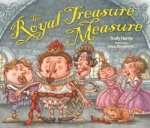
The Royal Treasure Measure
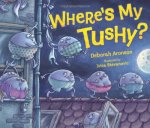
Where’s My Tushy?
.
Review HERE.

Filed under:
5stars,
Debut Author,
Favorites,
Library Donated Books,
Middle Grade,
Series Tagged:
Berenson Schemes series,
Caribbean Islands,
Darby Creek,
get-rich-quick schemes,
Ivica Stevanovic,
Jack Castaway,
Lerner Publishing Group,
Lisa Doan,
middle grade books,
reluctant readers,
whale shark 







 Today I'm thrilled to share a guest TeachingAuthor interview with the prolific and talented Debbie Dadey. We're honored to help Debbie celebrate the release of her latest chapter book, Treasure in Trident City (Aladdin), book eight in the Mermaid Tales series for ages 6-9. Here's a little about the story:
Today I'm thrilled to share a guest TeachingAuthor interview with the prolific and talented Debbie Dadey. We're honored to help Debbie celebrate the release of her latest chapter book, Treasure in Trident City (Aladdin), book eight in the Mermaid Tales series for ages 6-9. Here's a little about the story:
Pearl can't believe it! There is a pirate's treasure near Trident City. If she can find it, she'll be the richest, most famous mermaid ever. Tales of pirate ghosts don't scare Pearl off, but something much bigger just might.
See the end of this post for details on how to enter for a chance to win an autographed copy of this fun title! I also share the name of the winner of our last giveaway.
I'm guessing most of our
TeachingAuthors' readers are familiar with Debbie's work. She is the award-winning author/co-author of
158 books for children! She is perhaps most known for the best-selling
Adventures of the Bailey School Kids series (Scholastic) , which she wrote with Marcia Thornton Jones. Debbie and Marcia also co-wrote a writing book for adults,
Story Sparkers : A Creativity Guide for Children's Writers (Writer's Digest). A former elementary school teacher and school librarian, Debbie enjoys working with writers of all ages through school visits and writing conferences. She currently divides her time between Bucks County, PA and Sevierville, TN. She has three children, two dogs, and one very smart husband. You can learn more about Debbie
through her website and follow her via
Twitter and
Facebook.
I first connected with Debbie Dadey years ago, when a member of my critique group invited her to join
us. My son was in second grade at the time, and a
HUGE fan of the
Bailey School Kids. When I told him that Debbie had joined our group, he could hardly believe it. He said, "Wow, Mom, now you're going to be famous!" Well, knowing Debbie didn't make me "famous," but having her in our group definitely made me a "tighter" writer. Our group called Debbie "the slasher" because she was so great at helping us cut extraneous material. We were all disappointed when she moved away. All these years later, I'm happy to be able to still call her my friend.
And now, for the interview:
Debbie, would you tell our readers how you became a TeachingAuthor?
When I was an elementary school teacher, I taught writing to my students. When I was a PK-12th grade librarian, I taught writing to my students. As an author, it was only natural to continue teaching writing through continuing education classes at universities, school visits, and writing conferences.
My website has a writing section that I hope is helpful to writers of all ages.
Can you tell us a bit about your Mermaid Tales series and how you came to write it? What was the inspiration behind the newest book in the series, Treasure in Trident City? Are there more Mermaid Tales books in the works? Yes, there are more
Mermaid Tales books in the works.
Treasure in Trident City (think sunken pirate ship, pirate ghosts, and treasure!) is #8 and I have written 12 so far. It is a series about a school at the bottom of the ocean. The merboys and mermaids have normal school adventures, but also get the opportunity to have exciting interactions with ocean animals. In
Treasure in Trident City, Pearl becomes friends with a giant octopus! I was lucky enough that Simon and Schuster approached me about writing it.
I’m intrigued that Simon and Schuster approached you. Did they provide the general premise for the series and ask you to come up with the stories? Did they dictate number of books, plot ideas, etc.? Did you already have other series with them?They suggested a series about mermaids and let me run with it, but first they wanted me to create a world for them to live in, so I created a Travel Guide to Trident City which outlined the world. Of course, the one I gave to my editor had character sketches, a map (which the artist redrew for the books), and ideas for books. They did not say how many books they wanted to start with, but I thought four was a great number (since I had four main character) to try and they went for it. This was the first work I've done for Simon and Schuster. I thought it was interesting that they contacted me through my website and I was glad that I had a way on there for them to contact me! It doesn't have my email listed, but it comes directly to my email.
Your website highlights you as an author for “reluctant readers.” What is it about your books that appeals to reluctant readers? Do you have any tips for other writers who want to reach this audience?I hope my books are full of action, which I think draws in reluctant readers. I think books for any young reader needs to be kid-oriented and avoid overdosing on description.
You also list specific suggestions for parents and teachers to help motivate reluctant readers on your website. Which of these ideas to you think are most effective? There is nothing a parent or teacher can to do encourage reading more than modeling that behavior. Reading aloud to them and turning off the TV to read when your child can see speaks volumes!
You’re such a prolific author. Would you share a little about your writing schedule/routine? Do you set writing quotas/goals? Do you have any tricks for generating story/character ideas?I write every day, except Sunday. I begin my day by updating my website, Facebook fan page, and answering email. Then I dive into writing and strive for 3-4 pages per day and most of that is done in the morning. My
website, debbiedadey.com, has a writing section that has ‘worksheets’ that I use to help me learn about my character and my stories. I think they are helpful. My friend Marcia Jones and I created them for a book about writing called
Story Sparkers, which we are currently turning into an eBook.
You do so many school and library visits. Can you share a funny (or interesting) story about one?I’ll never forget the little boy who was crying in the hallway when I visited his school. Why was he crying? It was because he had thought the characters in the
Bailey School Kids books (my first series with Marcia Jones) were visiting. When he found out it was just me, he was devastated. To him, the characters were real and he really wanted to meet them!
Well, I can't think of a better compliment to your writing than that, Debbie! Thank you so much for taking time out from your busy schedule to visit with us. I hope all the teachers in our audience will visit the
Teacher's Page of Debbie's website for book-related activities and other resources. And I hope all our readers check back here on Wednesday, when Debbie shares a favorite writing exercise for our
Wednesday Writing Workout.

Now it's time for you to enter for a chance to win an autographed copy of
Treasure in Trident City (Aladdin). Use the Rafflecopter widget below to enter via 1, 2, or all 3 options specified.
If you choose the "comment" option, share a comment to TODAY'S blog post telling us what you'll do with the book should you win: save it for yourself or give it away? And please include your name in your comment, if it's not obvious from your comment "identity." (If you prefer, you may submit your comment via email to:
teachingauthors [at] gmail [dot] com. )
The giveaway
ends on May 30.
And congratulations to our most recent winner,
Elaine Kaplan, who follows us via email. Thanks for being a
TeachingAuthors subscriber, Elaine!
Good luck and happy writing!
Carmela
P.S. If you've never entered a Rafflecopter giveaway, here's info on
how to enter a Rafflecopter giveaway and the
difference between signing in with Facebook vs. with an email address. Email subscribers: if you received this post via email, you can click on the Rafflecopter link at the end of this message to access the entry form.
a Rafflecopter giveaway
By:
Trevor Laurence Jockims,
on 5/9/2014
Blog:
The Children's Book Review
(
Login to Add to MyJacketFlap)
JacketFlap tags:
The Three Little Pigs,
Wolf Books,
Ages 0-3,
Ages 4-8,
Picture Book,
Fairy Tales,
Picture Books,
Humor,
Pigs,
Fractured Fairy Tales,
Reluctant Readers,
Mark Teague,
Add a tag
A funny reimagining of the Three Little Pigs story, where the wolf isn’t so much big and bad but just hungry … and a bit grouchy.
In the ShadowsText Story by Kiersten White
Art and Art Story by Jim Di Bartolo
In the Shadows alternates between two related stories, one told in text and the other entirely in pictures. It's hard to talk about
In the Shadows without risking revealing too much. The stories themselves unfold gradually, and at first it's hard to understand what's going on or how the stories fit together, but as the details unfold the pieces start to come together.
The text portion alternates between five young people: Cora and Minnie, whose mother runs a boarding house in a small town in Maine; Arthur, a mysterious young man who comes to the boarding house; and two brothers, Thom and Charles. Charles is dying from a terminal illness, and their father sends the two young men from New York City to Maine for Charles' health, although a conversation that Thom overhears between his father and a woman seems to indicate a more sinister reason. The five teens begin to suspect that there is evil lurking in the town, and all five of them are linked to it in some way.
The art story depicts a young man traveling around the world, apparently searching for something or someone. We don't know who he is, and at first it's hard to understand what's going on or what the connection is with the text story. By about halfway through, you begin to suspect, and then later details in the text story make clear what's happening in the art story.
In the Shadows is an intriguing, beautifully made book. I love this kind of story, where the connections aren't always clear and you have to puzzle it out as you go along. I actually found that after I finished the book, I wanted to go through the art story again from the beginning to pick up on all the details and fully appreciate it.
The text story is well-written and holds your interest, the art is beautiful, and the two fit well together stylistically. There is a dark, creepy, and mysterious feel to both stories. With evil lurking in a small town in Maine, it's hard not to compare this to Stephen King, but stylistically it's not really similar to King's writing. The compelling story and short chapters conspire to keep you reading; "Just one more chapter," I kept telling myself.
Diversity?Other than a few incidental characters in the pictures, I didn't see any diversity.
Who would like this book:
With the short chapters, artwork, and fast-paced read, this may be a good book for reluctant readers. Graphic novel readers may also enjoy it, even though it isn't strictly a graphic novel. Any teen or adult who enjoys dark, creepy stories with mysterious conspiracies will enjoy
In the Shadows.Get it from:FTC required disclosure: Review copy sent by the publisher to enable me to write this review. The bookstore links above are affiliate links, and I earn a very small percentage of any sales made through the links. Neither of these things influenced my review.
It would not be an understatement to say that we are a family who loves books. For many generations it has been that way. My great-grandfather boasted of reading the complete Encyclopedia Britannica, 4 different editions throughout his life. My mother used the grocery money she saved by using coupons to buy leather bound editions of her favorite books. All 4 of my grandparents gave only books for gifts and do I need to mention our constant use of the public library?
When I had my own children, I just loved the daily connection we shared through our books. Stacked on shelves, and piled high on end tables, we were and are an active reading family. At around the age of 5 or 6, both our girls just took to letters, reading, and writing. We couldn’t keep them in enough books and writing paper. I noticed that though our son loved books, he wasn’t curious about them. He wasn’t intrigued by how momma and his family knew how to read those letters on the page. He wasn’t asking questions about letter sounds or asking what do these letters spell?
Slowly, at about 6 ½ years old , with our prompting, he started to read three-letter words but when asked to read them in a sentence or in his early reader, he would say, ”No thanks, that’s OK, it’s your turn to read”.
To say I wasn’t worried would be an understatement. I had everything tested and the conclusion was that he could see, hear, and think perfectly well. “He would evolve in his own time.” The tester said. “Not to worry.”
I took these words to heart but I couldn’t help feeling as though I had failed my sweet boy somehow. Later that day I called my dad. If there was ever someone who could solve a problem creatively, it would be my father.
“Well,” he said. “This isn’t an unusual problem. We’ve seen it quite a few times in our own family. Is what you need is a reading place.”

“A reading place?” I said.
“Yeah, there’s always one in every generation in our family who has a hard time reading. The only solution I can see is to build a reading place. A reading place calls the story forward and places it into the hands of the story reader. Afterwards you place it in the Book of Books as a testament to the time shared with a story. It works every time.”
“Ok dad, but first I want to know who was the one in your generation who couldn’t read?
“Me,” he said.
“And who is the one in my generation?”
“That would be the one I’m speaking with.” He said with much light-hearted sarcasm.
In utter disbelief I replied, “Me? As in me who has 4 books going at the same time?”
“Yes, that you! All of us are the youngest in our families. Why read, when one is completely surrounded by character and voice evoked storytellers? It’s time our little guy called up his own stories.”
Thinking back I remembered the barrel tunnel where I would sit and read out loud for hours. Next was the shelf my father put at the back of my closet. I always thought it was for my shoes. I read all of the Laura Ingalls Wilder books on that shelf with my flashlight in hand. Another favorite place was to make a huge fabric nest made out of fabric scraps in my mother’s studio.
So I had to ask, “Dad, where was your reading place?”
“There was an old fishing boat pulled up in the yard and laid on its side. There, I would sit and read. If the weather turned bad I had a canvas flap that I would pull down so I wouldn’t have to leave. In the winter I sat under the stairs.”
So with that we were off to build a few reading places of our very own.
How to build a reading place:
To call a story forward is a special thing indeed. In your story place you will want a sense of coziness and a place to curl up with a book or two.
Materials
- A standing foundation such as a table, end table, chairs, bunk beds, closet spaces, unused boats or bathtubs, a tree house or other pre-built fort.
- Blankets and/or sheets
- Pillows big and small
- Cardboard boxes if building a box structure. Home Depot has big refrigerator boxes for free.
- Long sticks if you are building a stick fort.
- Flashlights
- Connecting materials such as: duct tape, clamps, clips, and string.

There aren’t any rules on how to build your reading place. It can be permanent or moveable or a little of both. The important thing is that the readers of the family feel it is their place to go and delve into the pages of a book.
Once the reading place is built it is now time for the Reading Place Ceremony. For earlier or new readers, it’s always best to have at least one reader with them. As they become better readers, more and more time will be spent on their own.
The Reading Place Ceremony:
A reading place ceremony happens in three stages.
1. Calling the Story Forward

It’s time to call the story forward. Make sure that you’ve placed a stack of books in your reading place. If not, grab them now and bring them with you. Take your shortest book and read it aloud. If you are a new reader, read what you can even if it’s only small words or even identifying letters. After you’ve finished, your reading place is now open.
2. Read to a Partner, Read Aloud Family Style, or D.E.A.R. Time
For our second stage there are a few possibilities.
~ Read to a partner: Now that your reading place is officially open, it’s time to read with your trusted partner. First the young reader starts by reading a line and then the partner reads the next line. Continue like this until the book is finished. If there are a few people and you can share different copies, read the book in harmony, like a choir.
~ Read A-loud Family Style: Read the book you’ve chosen aloud in paragraphs. Each family member is going to get a turn as you pass the book around the circle.

~ D.E.A.R. Time: Which stands for Drop Everything and Read. As your young reader becomes more confident with reading, it’s good to let them read to themselves silently or out loud. Once I saw that my son was gaining confidence, I would give him 15 minutes of alone time after our read a-loud session.
3. The Book of Books
~ The third and final stage is celebrate the progress you’ve made and the time you’ve spent together. The Book of Books is a journal where you list the titles and authors of the books you have just read. Each person in the family is represented by a stamp. Those who took part in that reading session will put their stamp under the book title. It’s a great way to remember the books you’ve read and shared. There are more ideas about the Book of Books over at Jump Into A Book.
There are unlimited possibilities of creating reading places and how they function in your family. For us this is just what we needed to get our young reader reading. Almost weekly there is a new reading place going up somewhere in my house or yard. I hope wherever or however you choose to create your reading place that you will have many happy moments ahead. Happy Reading.
::::::::::::
Article previously published at Rhythm of The Home.
The post Oh, The Places We Shall Read {Creating a Special Reading Place} appeared first on Jump Into A Book.
By:
Trevor Laurence Jockims,
on 4/27/2014
Blog:
The Children's Book Review
(
Login to Add to MyJacketFlap)
JacketFlap tags:
Predators,
Animal Books,
Sharks,
Dan Santat,
Aaron Reynolds,
Carnivores,
Wolf Books,
Ages 4-8,
Picture Books,
Humor,
Reluctant Readers,
Wolves,
Lions,
Add a tag
A funny story about the (almost) soft side of nature’s predators, and the prey who don’t want to be friends with them anymore.
By:
Luisa LaFleur,
on 3/24/2014
Blog:
The Children's Book Review
(
Login to Add to MyJacketFlap)
JacketFlap tags:
Science,
Interactive,
Dragons,
Lego,
Reluctant Readers,
Gift Books,
featured,
Books for Boys,
Building,
Castles,
Activity Books,
Books into Movies,
Sean Kenney,
Spaceships,
LEGO Building,
Megan H. Rothrock,
Pirates,
Robots,
Ages 4-8,
Creativity,
Ages 9-12,
Picture Books,
Add a tag
All the excitement surrounding The LEGO Movie sparked a renewed interest in the venerable building toys at my house. The following books that include all kinds of tips, ideas and techniques to re-purpose existing LEGO pieces for all sorts of fantastic creations.
By:
Sue Morris,
on 3/18/2014
Blog:
Kid Lit Reviews
(
Login to Add to MyJacketFlap)
JacketFlap tags:
chapter books,
New York City,
Series,
reluctant readers,
children's book reviews,
Books for Boys,
Lady Liberty,
Metropolitan Museum of Art,
Digital Book,
Times Square,
New York Yankees,
Philadelphia Phillies,
4stars,
Karen Pokras Toz,
Grand Daisy Press,
fifth grade school trip,
Children's Books,
Add a tag
Today is a rather long post. Eleven-year-old Nate Rockledge, his older sister Abby, and his once best friend Lisa Crane are here for a short interview followed by a review of the new–and the final–Nate Rocks book: Nate Rocks the City. Let’s get started.

Today Kid Lit Reviews welcomes Nathan Rockledge (aka Nate Rocks), his older sister, Abby, and his know-it-all classmate, Lisa Crane. They are all characters in the Nate Rocks series, the newest being Nate Rocks the City. Since this is the last book, I thought it would be fun if you each talked about your favorite moment from the series. Who wants to go first?
Lisa Crane : Oh!! Me! Me!
Yes of course, Lisa, go ahead.
Lisa : Well … In Nate Rocks the Boat, there was this scene where Nathan was leaving for summer camp and his parents were giving him a going away party…
Nathan: Oh no! Really? Do we have to bring that up here?
Lisa: Hey! She said I could talk about my favorite moment from any of the books, right?
Nathan, please, Lisa, cont–
Lisa: So anyway, we were playing horseshoes – Nathan and me – and of course Nathan was missing them all, while I was getting them all. So I kindly offered to show Nathan how it’s done, only he got a little too close to me, and BAM the next thing you know, he’s on the ground crying like a big old baby. He says it’s because I hit him, but I think it’s because I beat him at horseshoes.
Nathan: You gave me a black eye!!
Abby: It was awesome.
Nathan: Can we move on?
Sure, Nathan. How abou–
Abby: Ooh – I have one!
You characters sure are, um, ready. Abby?
Abby: So in Nate Rocks the World, Nathan was trying to get back at me for – well that really doesn’t matter – anyway, he put food coloring in my shampoo bottle, but Dad wound up using it instead of me, and he wound up with PURPLE hair! HAHAHAHA! It was so funny, and Nathan got in so much trouble.
Nathan: You got in trouble, too.
Abby: Not as much as you though – it was classic.
Nathan: So far, this interview isn’t quite as much fun as I thought it was going to be.
I’m sorry, Nathan. You’re the star, so what is your favorite moment?
Nathan: Hmmm, that’s such a hard question because I had so many great moments in every book! I really did love going to New York City in this last book though. I got to save the city from aliens, I jousted with knights in the museum, and the last scene – well let’s just say if you’ve read Nate Rocks the World, I had a chance to go full circle. I don’t really want to give anymore away than that. Overall though, the entire series was a blast. I hope you all enjoyed it as much as I did – even the parts with Abby and Lisa.
Lisa: “Hey!”
Abby: “Not funny, Nate.”
Nathan: Thanks for reading and thanks for having us on your blog today!
~~~~~~~~~~~~~~~~~~~~~~~~~
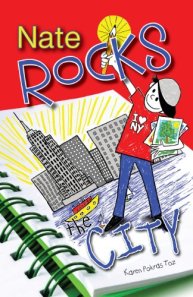 .
.
Nate Rocks the City 
by Karen Pokras Toz
Grand Daisy Press 2/14/2014
978-0-9848608-9- 0
Age 7 to 12 142 pages
.
Hey New York! Are you ready for Nate Rocks? Fifth grader Nathan Rockledge has been counting down the days—and meals—until his class trip to New York City. Now that the big event is finally here, he can barely stand the excitement. After all, isn’t this what being a fifth grader is all about? Oh sure, his Mom is one of the chaperones, his annoying sister Abby is tagging along, and that know-it-all classmate, Lisa, will be there as well. However, none of that matters. Not when he’ll be with his best friends, Tommy and Sam.
While seeing the sights, his teacher wants his class to take notes, but Nathan has other ideas. With paper and pencil in hand, Nathan prefers to doodle, transforming himself into Nate Rocks, boy hero. Amid ninja pigeons to fend off, aliens to attack, and the baseball game of the century to save, will Nate Rocks be able to save the day one more time?
Opening
“The piercing sound of the house alarm rips through the neighborhood as our car pulls into the driveway. ‘Nate! Come quick!’ Mrs. Jensen screams over the sound of the siren.”
The Story
Nate’s fifth grade class heads to New York City for their class trip. The chaperones include Nate’s mom and her best friend, Mrs. Crane, mother of the most annoying girl in the entire world—Lisa. Thanks to a Philadelphia Philly baseball player, the kids are getting two extra days and tickets the Phillies versus Yankees baseball game at the end of their trip. Nate counts his days by meals, starting with eleven meals. Nate savors every New York meal, even in the hotel cafeteria.
The group goes to Central Park, The City Zoo, the Statue of Liberty, and The Metropolitan Museum of Art before the final trip to Yankee Stadium. The last two days of the trip, Nate’s dad and older sister join the group. Mrs. Cogin, Nate’s teacher, gives each middle grader a journal to write notes about their trip as reference for an essay they will write later. Not much for words, Nate tends to draw his notes. Several times during the trip, Nate envisions himself as Nate Rocks, a hero to those around him. As Nate begins drawing the area around him changes. People are gone or settings change. Always, someone grabs him and an exchange like this occurs,
“Nate! Thank goodness we found you!”
“Me? Why me?”
“Why because you’re Nate Rocks, of course!”
Nate does whatever needs done, such as stop robotic birds from destroying New York City. The urgent task that only Nate Rocks can accomplished is competed and then this same adoring thanks occurs,
“You did it, Nate! You saved me/us!”
Finally, someone sharply brings Nate back to reality, reminding him that he is holding up the group or just annoying his mother. The last day of Nate’s trip to New York City culminates with a baseball game, the Philadelphia Phillies against the New York Yankees. Nate Rockledge goes out in Nate Rocks fashion one last time.
Review
Nate Rocks the City ends the Nate Rocks series. At age ten, Nate rocked the world and the boat and at age eleven, he rocked the school and now the city. In each one Nate envisions himself a hero, his current surroundings melting into a different scene and situations only an imaginative eleven-year-old boy can outwit. Nate’s biggest problem is fifth grader Lisa Crane. Lisa and Nate have spent a lot of time together as they grew up, thanks to their mothers being best friends. Nate sees Lisa as annoying and he is correct.
Ms. Toz writes like a pro. Punctuation errors, capitalization, spelling, and typos are all missing from Nate Rocks the City. One look at the credit page explains why the text is clean. Ms. Toz hired an editor from a company called There for You. Nate’s last story flows well from one scene to the next. His creativeness shines and makes his drawings come alive in his mind, on his pad, and for the reader. Ms. Toz thoroughly researched New York City and its sites before writing Nate Rocks the City. From the exhibits at The Metropolitan Museum of Art to the shops in Times Square, she has the details.
It is odd that both dad and Abby, Nick’s fifteen-year-old sister, would join the group midway through the fifth grade trip, like it were actually a family vacation. I suppose it was a way of getting all the usual characters into the story and for that, it is hard to place blame. Dad working as another chaperone at least fit nicely into the story, when he wasn’t getting the boys lost in the city, but Abby really made no sense.
All through the story—and in every Nate Rocks series—Nate envisions himself the hero of one situation or another. It is easy to know when Nick goes off on one of his tangents! You will find an exclamation point at the end of nearly every sentence! Nick sees these adventures as something exciting! At Yankee Stadium, Nate finally becomes that hero, exclamations not needed. I like the idea of Nate behind what happened, but the scene did not stand up. I would love to explain why, but it is the ending and I have no right to ruin it for anyone.
Nate Rocks the City is an enjoyable story with terrific imagination, too perfect annoying mom behavior, and a giant sense of fun kids will enjoy. The story is a fast read. Not wanting to leave the story helps this along. Kids will love Nate Rocks the City, whether as a fan of the series or a first time reader. Nate knows how to put on a show. Like the others, Nate Rocks the City can stand on its own, but read in order is more fun as Nate gets better with each book. The series is perfect for boys. Even young reluctant readers will find the Nate Rocks series worth keeping. I am sorry to see Nick leave us, but he does so in fine Nate fashion. Nate does indeed Rock the City!
Check out the Nate Rocks Series HERE.
Buy Nate Rocks the City at Amazon —B&N—author website—your neighborhood bookstore.
—B&N—author website—your neighborhood bookstore.
.
Meet the author, Karen Pokras Toz at her website: www.karentoz.com
Find other great books at Grand Daisy Press website: http://www.granddaisypress.com/
You can also find Karen Pokras Toz here:
Blog: http://kptoz.blogspot.com
Facebook: www.facebook.com/karenptoz
Twitter: www.twitter.com/karentoz
Amazon: http://bit.ly/amznNRTC
Barnes & Noble: http://bit.ly/bnNRTCity
Goodreads: http://www.goodreads.com/author/show/5009570.Karen_Pokras_Toz
.
NATE ROCKS THE CITY. Test copyright © 2014 by Karen Pokras Toz.
.
ALSO BY KAREN POKRAS TO

#1 Nate Rocks the World

#2 Nate Rocks the Boat

#3 Nate Rocks the School
– on sale! 99¢ through March 21, 2014

Millicent Marie Is Not My Name

Pie and Other Brilliant Ideas
.
.

..
Filed under:
4stars,
Books for Boys,
Children's Books,
Digital Book,
Series Tagged:
chapter books,
children's book reviews,
fifth grade school trip,
Grand Daisy Press,
Karen Pokras Toz,
Lady Liberty,
Metropolitan Museum of Art,
New York City,
New York Yankees,
Philadelphia Phillies,
reluctant readers,
Times Square 








By:
jilleisenberg14,
on 3/10/2014
Blog:
The Open Book
(
Login to Add to MyJacketFlap)
JacketFlap tags:
children's books,
holidays,
History,
diversity,
Reading Aloud,
reluctant readers,
women's history month,
Educators,
Wangari Maathai,
women in history,
Curriculum Corner,
Girls/women,
Add a tag
 Jill Eisenberg, our Resident Literacy Expert, began her career teaching English as a Foreign Language to second through sixth graders in Yilan, Taiwan as a Fulbright Fellow. She went on to become a literacy teacher for third grade in San Jose, CA as a Teach for America corps member. She is certified in Project Glad instruction to promote English language acquisition and academic achievement. In her column she offers teaching and literacy tips for educators.
Jill Eisenberg, our Resident Literacy Expert, began her career teaching English as a Foreign Language to second through sixth graders in Yilan, Taiwan as a Fulbright Fellow. She went on to become a literacy teacher for third grade in San Jose, CA as a Teach for America corps member. She is certified in Project Glad instruction to promote English language acquisition and academic achievement. In her column she offers teaching and literacy tips for educators.

Irena’s Jars Of Secrets
I entered the education field to broaden the minds of a new generation and teach the truths that I felt I had missed or was denied in my own education. Indeed, I was not alone in those motivations. According to the Primary Sources project by Scholastic and the Bill & Melinda Gates Foundation, of the more than 20,000 public school classroom teachers polled, 85% of teachers say they chose the profession in order to make a difference in children’s lives.
Despite my righteous ambitions, once in the classroom, I was hesitant to broach the conversation about gender with a mixed class of boys and girls. So many of my own college classes that focused on social justice and equality issues were almost entirely women.
Acutely aware of my students’ fragile perception of themselves, I was intimated by the prospect of guiding the discussion. When I was leading a classroom of my own, it was often easier to concentrate on the benign world of synonyms, dictionary skills, main idea, and genre features than push my students to think about what role gender plays in achievement, history, and identity.
I wondered: How do we teach about women’s history and contributions without alienating boys? Will boys disengage if a girl or woman is on the cover or is the main character? In this day and age, do girls still need explicit attention drawn to high-achievers that share their gender?
Leading up to my first month of March as a teacher, I thought I would “just” read more books with women as the central figures during Women’s History Month, but not explicitly point out that these were all women so as not to freak out boys and hope the girls would pick up on my subliminal messages of empowerment….

Insert face palm here.
This thinking was a huge disservice to ALL of my students’ educations. As I introduced books with prominent women historic figures or girl characters, I realized if the books were about gender, we would discuss identity and tolerance. Other times if the story just happened to have a girl character, but gender wasn’t a central feature of the story, my scholars just wanted to focus on the great story and how the universal lessons applied to their lives.
Four lessons to think about when teaching women’s history so both boys AND girls grow and learn:
- Two words: cool stories. Above all, if it’s a great story, it doesn’t matter who is on the cover. Everyone will want to sit up and participate.
- Pick contemporary and diverse stories. To continue to show the relevancy of the women’s movements and contributions of women to society, we owe it to all of our students to find more contemporary examples of women figures and showcase more diverse participants in equality. Let’s keep exposing our kids to women of today and of different backgrounds.
- Show explicit examples of men championing women. Boys need to see great role models of men advocating for women alongside or behind the scenes. There are plenty of men who have been in the trenches with women fighting for social
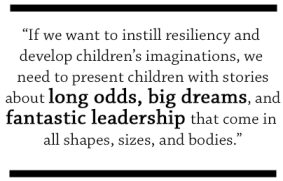 justice and as invested in their wives, daughters, sisters, and mothers achieving great success in a field of study as the women themselves. If we want future generations of men to respect and support women, we need to offer boys examples of how to recognize and champion women’s contributions. Boys and girls need to see that the struggles for equality impacted everyone and were not about one group’s success at the other’s detriment.
justice and as invested in their wives, daughters, sisters, and mothers achieving great success in a field of study as the women themselves. If we want future generations of men to respect and support women, we need to offer boys examples of how to recognize and champion women’s contributions. Boys and girls need to see that the struggles for equality impacted everyone and were not about one group’s success at the other’s detriment.
- Talk about the universal lesson and character traits. Everyone can learn from a story about overcoming obstacles, persistence, and courage. Women like Wangari Maathai and Pura Belpré fought for what they loved and believed was right first, and then fought for who they were and who they represented. If we want to instill resiliency and develop children’s imaginations, we need to present children with stories about long odds, big dreams, and fantastic leadership that come in all shapes, sizes, and bodies.
Throughout the year and especially during Women’s History Month, we need to teach that gender shouldn’t be an excuse to bar someone from exploring or contributing to a field of study. Concurrently, we want to show all students that gender can offer a unique perspective or approach that should be recognized and celebrated.
Alongside our girls, boys need the language of equality and a broader view of history. Women’s contributions advanced our society and continue to impact all of us. We need to teach that gender totally does matter and, at the same time, totally doesn’t matter.

Shining Star: The Story Of Anna May Wong
Susan B. Anthony Is Great, But Who Else Do We Have? Here are books about high-achieving women from diverse backgrounds with diverse pursuits.

Baby Flo: Florence Mills Lights Up The Stage
Women and The Men That Championed Them. Explore these books with awesome men celebrating awesome women:

Killer Of Enemies
Stories That Will Hook ’Em All. Here are stories so fun that it won’t matter who is on the cover…but the cover just happens to feature a girl:
Filed under:
Curriculum Corner Tagged:
children's books,
diversity,
Educators,
Girls/women,
History,
holidays,
Reading Aloud,
reluctant readers,
Wangari Maathai,
women in history,
women's history month 

View Next 25 Posts
 I’d like to take a side road of sorts in continuing our TeachingAuthors discussion on writers’ reader considerations.
I’d like to take a side road of sorts in continuing our TeachingAuthors discussion on writers’ reader considerations. Here’s the poem I first submitted, in celebration of National Hat Month:
Here’s the poem I first submitted, in celebration of National Hat Month: Hmmm…National Write a Letter of Appreciation Week?
Hmmm…National Write a Letter of Appreciation Week?




























 x
x










 x
x
 With claws!
With claws! the stories begin. Oh, yes, Jesper Jinx is Finnish author, Marco Kitti’s first English language chapter book.
the stories begin. Oh, yes, Jesper Jinx is Finnish author, Marco Kitti’s first English language chapter book.












 Back in 2005, I started writing a book based on something that really happened: a blind girl who was briefly and accidentally kidnapped when her parents left the keys in the car and someone stole it. Only in my book, the thief kept the girl and she had to figure out how to escape.
Back in 2005, I started writing a book based on something that really happened: a blind girl who was briefly and accidentally kidnapped when her parents left the keys in the car and someone stole it. Only in my book, the thief kept the girl and she had to figure out how to escape.




































